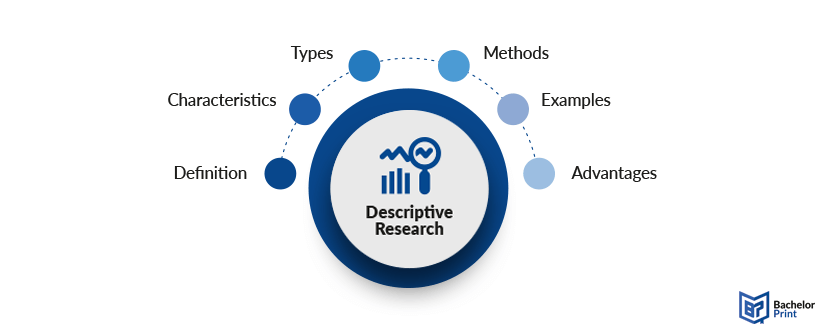- Privacy Policy

Home » Descriptive Research Design – Types, Methods and Examples

Descriptive Research Design – Types, Methods and Examples
Table of Contents
Descriptive research design is a crucial methodology in social sciences, education, healthcare, and business research. It focuses on describing characteristics, behaviors, or phenomena as they exist without influencing or manipulating the study environment. This type of research provides a snapshot of specific conditions or attributes, making it an essential approach for understanding trends, patterns, and relationships.
This article explores the concept of descriptive research design, its types, methods, and practical examples, providing a comprehensive understanding of its significance and applications.

Descriptive Research Design
Descriptive research design is a systematic methodology used to describe the characteristics of a population, event, or phenomenon. Unlike experimental research, which tests hypotheses, descriptive research answers “what,” “where,” “when,” and “how” questions. It does not examine causation but rather provides detailed information about existing conditions.
For example, a study describing the demographics of university students enrolled in online courses would employ a descriptive research design.
Importance of Descriptive Research Design
Descriptive research design is vital for:
- Establishing Baseline Data: It provides foundational knowledge to guide further research.
- Identifying Trends: It captures trends and patterns in behavior or phenomena.
- Informing Decision-Making: Organizations and policymakers rely on descriptive research for data-driven decisions.
- Understanding Complex Phenomena: It helps summarize and explain intricate systems or populations.
This design is widely used in fields such as sociology, psychology, marketing, and healthcare to generate valuable insights.
Types of Descriptive Research Design
1. cross-sectional research.
This type involves collecting data from a population or sample at a single point in time.
- Purpose: To describe the current status or characteristics of a population.
- Example: A survey measuring customer satisfaction with a product conducted in January.
2. Longitudinal Research
Longitudinal research collects data from the same subjects over an extended period, allowing researchers to observe changes and trends.
- Purpose: To identify patterns or changes over time.
- Example: Tracking changes in dietary habits among adolescents over five years.
3. Comparative Research
This design compares two or more groups or phenomena to highlight differences and similarities.
- Purpose: To explore variations and relationships between subjects.
- Example: Comparing stress levels between urban and rural employees.
4. Case Study Research
Case studies provide an in-depth examination of a single subject, group, or event.
- Purpose: To gain detailed insights into complex issues.
- Example: Analyzing the strategies of a successful startup to identify factors contributing to its growth.
Methods of Descriptive Research Design
1. surveys and questionnaires.
Surveys are the most common method in descriptive research, using structured or semi-structured questions to gather data.
- Easy to administer to large populations.
- Cost-effective.
- Example: Conducting a survey to determine customer preferences for smartphone features.
2. Observations
This method involves observing and recording behaviors, events, or conditions without interference.
- Provides real-time, naturalistic data.
- Useful for studying non-verbal behaviors.
- Example: Observing classroom interactions to analyze teacher-student dynamics.
Types of Observations
- Example: Observing a team meeting as a team member.
- Example: Watching interactions from a one-way mirror.
3. Secondary Data Analysis
Analyzing pre-existing data, such as government reports, academic articles, or historical records.
- Saves time and resources.
- Provides access to large datasets.
- Example: Using census data to describe population growth trends.
4. Interviews
Interviews involve asking open-ended or structured questions to gather in-depth information.
- Offers detailed insights and clarifications.
- Facilitates exploration of subjective experiences.
- Example: Conducting interviews with employees to understand workplace satisfaction.
5. Case Studies
Involves a deep dive into a specific instance to understand complex phenomena.
- Provides rich, contextualized data.
- Suitable for unique or rare cases.
- Example: Studying the response of a hospital to a public health emergency.
Steps in Conducting Descriptive Research
Step 1: define the research problem.
Clearly outline what you aim to describe and why it is significant.
- Example: “What are the shopping preferences of millennials in urban areas?”
Step 2: Select the Population or Sample
Identify the group you will study and ensure it represents the target population.
- Example: Randomly selecting 500 participants from an urban demographic.
Step 3: Choose the Data Collection Method
Select the most appropriate method based on the research problem and objectives.
- Example: Using a survey to collect data on customer satisfaction.
Step 4: Gather Data
Administer the survey, conduct interviews, or collect observations systematically.
Step 5: Analyze Data
Summarize findings using statistical or thematic analysis, depending on the nature of the data.
- Quantitative Data: Use statistical tools to identify trends.
- Qualitative Data: Use coding techniques to identify themes.
Step 6: Report Results
Present findings clearly and concisely, often with visuals like graphs, charts, and tables.
Examples of Descriptive Research Design
1. healthcare research.
Study: Assessing patient satisfaction in a hospital.
- Method: Distributing surveys to patients.
- Outcome: Identified areas of improvement in hospital services, such as wait times and staff communication.
2. Marketing Research
Study: Exploring customer preferences for eco-friendly packaging.
- Method: Conducting interviews and focus groups.
- Outcome: Revealed that consumers prefer biodegradable packaging and are willing to pay a premium for it.
3. Education Research
Study: Analyzing attendance patterns among college students.
- Method: Collecting secondary data from attendance records.
- Outcome: Found that attendance declines during midterm weeks, suggesting a need for academic support.
4. Social Research
Study: Examining the impact of social media usage on youth communication skills.
- Method: Observing and surveying participants.
- Outcome: Highlighted that frequent social media use correlates with reduced face-to-face communication skills.
Advantages of Descriptive Research Design
- Easy Implementation: Methods like surveys and observations are straightforward and cost-effective.
- Broad Applications: Can be used across disciplines to gather diverse data.
- Non-Intrusive: Describes phenomena without altering them, preserving natural behavior.
- Rich Data: Provides detailed insights into current states or conditions.
Limitations of Descriptive Research Design
- No Causal Relationships: It does not establish cause-and-effect relationships.
- Bias Potential: Surveys and observations may be subject to bias.
- Limited Scope: Restricted to describing existing conditions, limiting predictive capabilities.
Descriptive research design is an invaluable tool for understanding the characteristics and trends of a population or phenomenon. By employing methods such as surveys, observations, and secondary data analysis, researchers can gather rich, detailed insights that inform decision-making and guide further studies. While it does not explore causation, descriptive research provides a foundation for hypotheses and experimental research, making it a cornerstone of empirical inquiry.
- Creswell, J. W. (2018). Research Design: Qualitative, Quantitative, and Mixed Methods Approaches . Sage Publications.
- Babbie, E. (2020). The Practice of Social Research . Cengage Learning.
- Bryman, A. (2016). Social Research Methods . Oxford University Press.
- Silverman, D. (2020). Interpreting Qualitative Data . Sage Publications.
- Flick, U. (2018). An Introduction to Qualitative Research . Sage Publications.
About the author
Muhammad Hassan
Researcher, Academic Writer, Web developer
You may also like

Research Methods – Types, Examples and Guide

Survey Research – Types, Methods, Examples

Transformative Design – Methods, Types, Guide

Textual Analysis – Types, Examples and Guide

Case Study – Methods, Examples and Guide

Quantitative Research – Methods, Types and...

Descriptive Research
Descriptive research can be explained as a statement of affairs as they are at present with the researcher having no control over variable. Moreover, “descriptive studies may be characterised as simply the attempt to determine, describe or identify what is, while analytical research attempts to establish why it is that way or how it came to be” [1] . Three main purposes of descriptive studies can be explained as describing, explaining and validating research findings. This type of research is popular with non-quantified topic.
Descriptive research is “aimed at casting light on current issues or problems through a process of data collection that enables them to describe the situation more completely than was possible without employing this method.” [2] To put it simply, descriptive studies are used to describe various aspects of the phenomenon. In its popular format, descriptive research is used to describe characteristics and/or behaviour of sample population. It is an effective method to get information that can be used to develop hypotheses and propose associations.
Importantly, these types of studies do not focus on reasons for the occurrence of the phenomenon. In other words, descriptive research focuses on the question “What?”, but it is not concerned with the question “Why?”
Descriptive studies have the following characteristics:
1. While descriptive research can employ a number of variables, only one variable is required to conduct a descriptive study.
2. Descriptive studies are closely associated with observational studies, but they are not limited with observation data collection method. Case studies and surveys can also be specified as popular data collection methods used with descriptive studies.
3. Findings of descriptive researches create a scope for further research. When a descriptive study answers to the question “What?”, a further research can be conducted to find an answer to “Why?” question.
Examples of Descriptive Research
Research questions in descriptive studies typically start with ‘What is…”. Examples of research questions in descriptive studies may include the following:
- What are the most effective intangible employee motivation tools in hospitality industry in the 21 st century?
- What is the impact of viral marketing on consumer behaviour in consumer amongst university students in Canada?
- Do corporate leaders of multinational companies in the 21 st century possess moral rights to receive multi-million bonuses?
- What are the main distinctive traits of organisational culture of McDonald’s USA?
- What is the impact of the global financial crisis of 2007 – 2009 on fitness industry in the UK?
Advantages of Descriptive Research
- Effective to analyse non-quantified topics and issues
- The possibility to observe the phenomenon in a completely natural and unchanged natural environment
- The opportunity to integrate the qualitative and quantitative methods of data collection. Accordingly, research findings can be comprehensive.
- Less time-consuming than quantitative experiments
- Practical use of research findings for decision-making
Disadvantages of Descriptive Research
- Descriptive studies cannot test or verify the research problem statistically
- Research results may reflect certain level of bias due to the absence of statistical tests
- The majority of descriptive studies are not ‘repeatable’ due to their observational nature
- Descriptive studies are not helpful in identifying cause behind described phenomenon
My e-book, The Ultimate Guide to Writing a Dissertation in Business Studies: a step by step assistance contains discussions of theory and application of research designs. The e-book also explains all stages of the research process starting from the selection of the research area to writing personal reflection. Important elements of dissertations such as research philosophy , research approach , methods of data collection , data analysis and sampling are explained in this e-book in simple words.
John Dudovskiy

[1] Ethridge, D.E. (2004) “Research Methodology in Applied Economics” John Wiley & Sons, p.24
[2] Fox, W. & Bayat, M.S. (2007) “A Guide to Managing Research” Juta Publications, p.45

Descriptive Research: Definition, Methods, Types & Examples
- July 18, 2024
Dr. Marvin L. Smith
Descriptive research is a cornerstone of scientific inquiry, providing a systematic approach to observing and documenting phenomena without manipulation. This method is essential for researchers seeking to paint a detailed picture of real-world situations, behaviors, or characteristics.
By employing various data collection techniques, descriptive research offers valuable insights across diverse fields, from psychology and sociology to business and education. Its non-experimental nature makes it particularly useful for exploring new areas of study, establishing baselines, and identifying patterns or trends.
As a fundamental tool in the researcher’s arsenal, descriptive research lays the groundwork for more complex investigations and plays a crucial role in advancing our understanding of the world around us.
Table of Contents
What is descriptive research?
Descriptive research is a type of research methodology that aims to systematically describe, explain, and interpret a phenomenon, situation, or population without manipulating variables or establishing cause-and-effect relationships.
It focuses on providing a detailed and accurate picture of the characteristics, behaviors, or attributes of a particular group, event, or subject matter.
This approach involves collecting, analyzing, and presenting data to create a comprehensive understanding of the topic being studied, often using various tools such as surveys, observations, and case studies.
Descriptive research examples
Descriptive research can be applied to a wide range of fields and topics. Here are some examples to illustrate its diverse applications:
- Market research: A company surveys to understand customer preferences and buying habits for a new product line. They collect data on demographics, purchasing frequency, and product features that appeal most to consumers.
- Educational studies: Researchers observe and document classroom behaviors to describe student engagement levels in different teaching environments, such as traditional lectures versus interactive group activities.
- Public health: A study examines the prevalence of obesity in a specific community by collecting data on body mass index (BMI), dietary habits, and physical activity levels of residents.
- Environmental science: Scientists conduct a detailed inventory of plant and animal species in a particular ecosystem, describing their distribution, abundance, and interactions.
- Sociology: A researcher investigates social media usage patterns among teenagers, describing the types of platforms used, time spent online, and the nature of content shared.
- Psychology: A study describes the coping mechanisms employed by individuals dealing with chronic stress, categorizing and explaining various strategies observed.
- Urban planning: Researchers document the current state of public transportation in a city, including route coverage, ridership statistics, and accessibility for different neighborhoods.
- Anthropology: An ethnographic study describes the cultural practices, rituals, and social structures of an indigenous community, providing a detailed account of their way of life.
- Organizational behavior: A company conducts an employee satisfaction survey, describing factors that contribute to job satisfaction and identifying areas for improvement in the workplace.
- Historical research: A historian provides a detailed description of daily life in a specific time period, based on analysis of primary sources such as diaries, letters, and official records.
When to use descriptive research
Descriptive research is a valuable approach in many scenarios, particularly when the goal is to gain a comprehensive understanding of a situation, phenomenon, or population. Here are some key instances when using descriptive research is most appropriate:
1. Exploring new areas of study:
When investigating a topic that has been little researched or is entirely new, descriptive research can provide a foundational understanding. It helps in identifying key variables and patterns that can guide future, more focused studies.
2. Documenting current conditions:
When the aim is to capture a detailed snapshot of a current situation or state of affairs, descriptive research is ideal. This could involve describing the characteristics of a population, the features of a particular environment, or the current practices in an organization.
3. Identifying problems or justifying current conditions:
Descriptive research can highlight issues or validate existing circumstances in a given context. For example, it can reveal disparities in healthcare access or confirm the effectiveness of certain educational practices.
4. Developing hypotheses for future research:
By providing a comprehensive picture of a situation, descriptive research can help in formulating hypotheses for more targeted, experimental studies in the future.
5. Making comparisons:
When the goal is to compare different groups, time periods, or conditions, descriptive research can provide the necessary data for these comparisons.
6. Measuring trends over time:
Descriptive studies conducted at regular intervals can track changes and developments in a particular field or population over time.
7. Gathering information for decision-making:
In business and policy-making, descriptive research can provide crucial information to inform strategic decisions and policy formulation.
8. Understanding complex social phenomena:
For intricate social issues that are difficult to manipulate experimentally, descriptive research offers a way to study them in their natural context.
9. Preliminary stages of a larger study:
As an initial phase in a more extensive research project, descriptive research can help in defining the scope and direction of subsequent investigations.
10. When ethical constraints prevent experimental manipulation:
In situations where it would be unethical to manipulate variables (e.g., certain medical or psychological studies), descriptive research provides a means to study phenomena without intervention.
Ready to transform your writing experience?
Sign up for Blainy today and start writing your papers with confidence!
Descriptive research methods
Descriptive research employs a variety of methods to collect and analyze data, each suited to different types of studies and research questions. Here are some of the primary methods used in descriptive research:
1. Surveys and Questionnaires:
These are widely used to gather information from a large number of participants. Surveys can be conducted online, by mail, over the phone, or in person. They typically include structured questions that can be easily quantified and analyzed.
Example: A national health survey collecting data on dietary habits and exercise routines across different age groups.
2. Observational Studies:
Researchers observe and record behaviors, events, or characteristics in their natural setting without intervention. This can be done through direct observation or using technology like cameras or sensors.
Example: An anthropologist observing and documenting the daily routines of a particular community.
3. Case Studies:
This method involves an in-depth investigation of a single individual, group, or event. It provides detailed, contextual analysis of a limited number of events or conditions and their relationships.
Example: A detailed study of a company’s successful implementation of a new management strategy.
4. Interviews:
Researchers conduct one-on-one conversations with participants to gather detailed information. Interviews can be structured, semi-structured, or unstructured, depending on the research needs.
Example: In-depth interviews with long-term residents to understand the social changes in a neighborhood over time.
5. Focus Groups:
This involves gathering a small group of people to discuss a specific topic. The interaction between participants can provide insights that might not emerge in individual interviews.
Example: A focus group discussion on consumer perceptions of a new product line.
6. Content Analysis:
This method involves systematically analyzing the content of documents, media, or other materials to identify patterns or themes.
Example: Analyzing the portrayal of gender roles in popular television shows over the past decade.
7. Archival Research:
This involves examining existing records, documents, and artifacts to gather historical or longitudinal data.
Example: Studying climate patterns using historical weather records.
8. Naturalistic Observation:
Researchers observe subjects in their natural environment without any manipulation or interference.
Example: Observing children’s play behaviors in a school playground.
9. Cross-sectional Studies:
These involve collecting data from a population at a specific point in time, often to compare different population subgroups.
Example: A study comparing job satisfaction levels across different industries at a given time.
10. Longitudinal Studies:
These track the same sample over an extended period, allowing researchers to observe changes over time.
Example: Following a cohort of individuals from adolescence to adulthood to study career development patterns.
Descriptive research is a fundamental approach in scientific inquiry, offering a versatile toolkit for understanding and documenting various phenomena. It’s particularly valuable for exploring new areas, capturing current conditions, and laying the groundwork for future studies.
Methods range from surveys and observations to case studies and content analysis, often used in combination for comprehensive insights. While not focused on causal explanations, descriptive research provides rich, detailed information crucial for informed decision-making and hypothesis generation.
Its applications span numerous fields, making it an essential skill for students, researchers, and professionals. As we face complex global challenges, descriptive research remains vital in our quest to understand and improve the world.
About the Author:

How to Fix and Prevent Run-on Sentences

Research Gaps: How to Identify, Types, and Examples Explained

Is Using ChatGPT Cheating?

Blainy vs. ChatGPT

FANBOYS: Coordinating Conjunctions

Research Findings Guide: Examples, Types, and Structuring Tips


Academic writing made brilliantly simple, always.
Limited time offers 🎁🎉.
Black Friday Sale
Cyber Monday Sale
Discover More
50+ Free AI Tools
Feature Updates
✉ [email protected]
✆ +971 50 760 0820
📍190 Hackett Inlet, Eastern Region, Dubai, UAE.
Terms & Condition
Privacy Policy
Copyright © 2024 Blainy

What is Descriptive Research and How is it Used?

Introduction
What does descriptive research mean, why would you use a descriptive research design, what are the characteristics of descriptive research, examples of descriptive research, what are the data collection methods in descriptive research, how do you analyze descriptive research data, ensuring validity and reliability in the findings.
Conducting descriptive research offers researchers a way to present phenomena as they naturally occur. Rooted in an open-ended and non-experimental nature, this type of research focuses on portraying the details of specific phenomena or contexts, helping readers gain a clearer understanding of topics of interest.
From businesses gauging customer satisfaction to educators assessing classroom dynamics, the data collected from descriptive research provides invaluable insights across various fields.
This article aims to illuminate the essence, utility, characteristics, and methods associated with descriptive research, guiding those who wish to harness its potential in their respective domains.

At its core, descriptive research refers to a systematic approach used by researchers to collect, analyze, and present data about real-life phenomena to describe it in its natural context. It primarily aims to describe what exists, based on empirical observations .
Unlike experimental research, where variables are manipulated to observe outcomes, descriptive research deals with the "as-is" scenario to facilitate further research by providing a framework or new insights on which continuing studies can build.
Definition of descriptive research
Descriptive research is defined as a research method that observes and describes the characteristics of a particular group, situation, or phenomenon.
The goal is not to establish cause and effect relationships but rather to provide a detailed account of the situation.
The difference between descriptive and exploratory research
While both descriptive and exploratory research seek to provide insights into a topic or phenomenon, they differ in their focus. Exploratory research is more about investigating a topic to develop preliminary insights or to identify potential areas of interest.
In contrast, descriptive research offers detailed accounts and descriptions of the observed phenomenon, seeking to paint a full picture of what's happening.
The evolution of descriptive research in academia
Historically, descriptive research has played a foundational role in numerous academic disciplines. Anthropologists, for instance, used this approach to document cultures and societies. Psychologists have employed it to capture behaviors, emotions, and reactions.
Over time, the method has evolved, incorporating technological advancements and adapting to contemporary needs, yet its essence remains rooted in describing a phenomenon or setting as it is.

Descriptive research serves as a fundamental part of research given its ability to provide a detailed snapshot of life. Its unique qualities and methods make it an invaluable method for various research purposes. Here's why:
Benefits of obtaining a clear picture
Descriptive research captures the present state of phenomena, offering researchers a detailed reflection of situations. This unaltered representation is important for research fields like marketing, where understanding current consumer behavior can shape future strategies.
Facilitating data interpretation
Given its straightforward nature, descriptive research can provide data that's easier to interpret, both for researchers and their audiences. Rather than analyzing complex statistical relationships among variables, researchers present detailed descriptions of their qualitative observations . Researchers can engage in in-depth analysis relating to their research question , but audiences can also draw insights from their own interpretations or reflections on potential underlying patterns.
Enhancing the clarity of the research problem
By presenting things as they are, descriptive research can help elucidate ambiguous research questions. A well-executed descriptive study can shine light on overlooked aspects of a problem, paving the way for further investigative research.
Addressing practical problems
In real-world scenarios, it's not always feasible to manipulate variables or set up controlled experiments. For instance, in social sciences, understanding cultural norms as they happen is an important principle in data collection and analysis. Descriptive research allows for the capturing of such developments in their natural context, ensuring genuine understanding.
Building a foundation for future research
Often, descriptive studies act as stepping stones for more complex research endeavors. By establishing baseline data and highlighting patterns, they create a platform upon which more intricate hypotheses can be built and tested in subsequent studies.

Descriptive research is distinguished by a set of fundamental characteristics that set it apart from other research methodologies . Recognizing these features can help researchers effectively design, implement , and interpret descriptive studies.
Specificity in the research question
As with all research, descriptive research starts with a well-defined research question aiming to detail a particular phenomenon. The specificity ensures that the study remains focused on gathering relevant data without unnecessary deviations.
Focus on the present situation
While some research methods aim to predict future trends or uncover historical truths, descriptive research is predominantly concerned with the present. It seeks to capture the current state of affairs, such as understanding today's consumer habits or documenting a newly observed phenomenon.
Standardized and structured methodology
To ensure credibility and consistency in results, descriptive research often employs standardized methods. Whether it's using a fixed set of survey questions or adhering to specific observation protocols, this structured approach ensures that data is collected uniformly, making it easier to compare and analyze.
Replicability and consistency in results
Due to its structured methodology, findings from descriptive research can often be replicated in different settings or with different samples. This consistency adds to the credibility of the results, reinforcing the validity of the insights drawn from the study.

Analyze data quickly and efficiently with ATLAS.ti
Download a free trial to see how you can make sense of complex qualitative data.
Numerous fields and sectors conduct descriptive research for its versatile and detailed nature. Through its focus on presenting things as they naturally occur, it provides insights into a myriad of scenarios. Here are some tangible examples from diverse domains:
Conducting market research
Businesses often turn to data analysis through descriptive research to understand the demographics of their target market. For instance, a company launching a new product might survey potential customers to understand their age, gender, income level, and purchasing habits, offering valuable data for targeted marketing strategies.
Evaluating employee behaviors
Organizations rely on descriptive research designs to assess the behavior and attitudes of their employees. By conducting observations or surveys , companies can gather data on workplace satisfaction, collaboration patterns, or the impact of a new office layout on productivity.

Understanding consumer preferences
Brands aiming to understand their consumers' likes and dislikes often use descriptive research. By observing shopping behaviors or conducting product feedback surveys , they can gauge preferences and adjust their offerings accordingly.
Documenting historical patterns
Historians and anthropologists employ descriptive research to identify patterns through analysis of events or cultural practices. For instance, a historian might detail the daily life in a particular era, while an anthropologist might document rituals and ceremonies of a specific tribe.
Assessing student performance
Educational researchers can utilize descriptive studies to understand the effectiveness of teaching methodologies. By observing classrooms or surveying students, they can measure data trends and gauge the impact of a new teaching technique or curriculum on student engagement and performance.

Descriptive research methods aim to authentically represent situations and phenomena. These techniques ensure the collection of abundant and reliable data about the subject of interest.
The most appropriate descriptive research method depends on the research question and resources available for your research study.
Surveys and questionnaires
One of the most familiar tools in the researcher's arsenal, surveys and questionnaires offer a structured means of collecting data from a vast audience. Through carefully designed questions, researchers can obtain standardized responses that lend themselves to straightforward comparison and analysis in quantitative and qualitative research .
Survey research can manifest in various formats, from face-to-face interactions and telephone conversations to digital platforms. While surveys can reach a broad audience and generate quantitative data ripe for statistical analysis, they also come with the challenge of potential biases in design and rely heavily on respondent honesty.
Observations and case studies
Direct or participant observation is a method wherein researchers actively watch and document behaviors or events. A researcher might, for instance, observe the dynamics within a classroom or the behaviors of shoppers in a market setting.
Case studies provide an even deeper dive, focusing on a thorough analysis of a specific individual, group, or event. These methods present the advantage of capturing real-time, detailed data, but they might also be time-intensive and can sometimes introduce observer bias .
Interviews and focus groups
Interviews , whether they follow a structured script or flow more organically, are a powerful means to extract detailed insights directly from participants. On the other hand, focus groups gather multiple participants for discussions, aiming to gather diverse and collective opinions on a particular topic or product.
These methods offer the benefit of deep insights and adaptability in data collection . However, they necessitate skilled interviewers, and focus group settings might see individual opinions being influenced by group dynamics.
Document and content analysis
Here, instead of generating new data, researchers examine existing documents or content . This can range from studying historical records and newspapers to analyzing media content or literature.
Analyzing existing content offers the advantage of accessibility and can provide insights over longer time frames. However, the reliability and relevance of the content are necessary qualities in descriptive research, and researchers must approach this method with a discerning eye.

Descriptive research data, rich in details and insights, necessitates meticulous analysis to derive meaningful conclusions. The analysis process transforms raw data into structured findings that can be communicated and acted upon.
Qualitative content analysis
For data collected through interviews , focus groups , observations , or open-ended survey questions , qualitative content analysis is a popular choice. This involves examining non-numerical data to identify patterns, themes, or categories.
By coding responses or observations , researchers can identify recurring elements, making it easier to comprehend larger data sets and draw insights.
Using descriptive statistics
When dealing with quantitative data from surveys or experiments, descriptive statistics are invaluable. Measures such as mean, median, mode, standard deviation, and frequency distributions help summarize data sets, providing a snapshot of the overall patterns.
Graphical representations like histograms, pie charts, or bar graphs can further help in visualizing these statistics.
Coding and categorizing the data
Both qualitative and quantitative data often require coding. Coding involves assigning labels to specific responses or behaviors to group similar segments of data. This categorization aids in identifying patterns, especially in vast data sets.
For instance, responses to open-ended questions in a survey can be coded based on keywords or sentiments, allowing for a more structured analysis.
Visual representation through graphs and charts
Visual aids like graphs, charts, and plots can simplify complex data, making it more accessible and understandable. Whether it's showcasing frequency distributions through histograms or mapping out relationships with networks, visual representations can help researchers effectively identify trends and patterns in their data.
The credibility of findings is paramount in any qualitative research . Without trustworthiness in the results, even the most meticulously gathered data can lose its value. Two qualities that bolster the credibility of research outcomes are validity and reliability .
Validity: Measuring the right thing
Validity addresses the accuracy of the research. It seeks to answer the question: Is the research genuinely measuring what it aims to measure? In descriptive research, where the objective is to paint an authentic picture of the current state of affairs, researchers are responsible for establishing the necessary validity in their research design.
For instance, if a study aims to understand consumer preferences for a product category, the questions posed should genuinely reflect those preferences and not veer into unrelated territories. Multiple forms of validity, including content, criterion, and construct validity, can be examined to ensure that the research instruments and processes are aligned with the research goals.
Reliability: Consistency in findings
Reliability, on the other hand, refers to the consistency of the research findings. When a study demonstrates reliability, this suggests that others could repeat the study and the outcomes would remain consistent across repetitions.
In descriptive research, factors like the clarity of survey questions , the training of observers , and the standardization of interview protocols play a role in enhancing reliability. Techniques such as test-retest and internal consistency measurements can be employed to assess and improve reliability.

Make your research happen with ATLAS.ti
Analyze descriptive research with our powerful data analysis interface. Download a free trial of ATLAS.ti.


Transcription Service for Your Academic Paper
Start Transcription now
Editing & Proofreading for Your Research Paper
Get it proofread now
Online Printing & Binding with Free Express Delivery
Configure binding now
- Academic essay overview
- The writing process
- Structuring academic essays
- Types of academic essays
- Academic writing overview
- Sentence structure
- Academic writing process
- Improving your academic writing
- Stylistic devices
- Titles and headings
- APA style overview
- APA citation & referencing
- APA structure & sections
- Citation & referencing
- Structure and sections
- APA examples overview
- Commonly used citations
- Other examples
- British English vs. American English
- Chicago style overview
- Chicago citation & referencing
- Chicago structure & sections
- Chicago style examples
- Citing sources overview
- Citation format
- Citation examples
- College essay overview
- Application
- How to write a college essay
- Types of college essays
- Commonly confused words
- Definitions
- Dissertation overview
- Dissertation structure & sections
- Dissertation writing process
- Graduate school overview
- Application & admission
- Study abroad
- Harvard referencing overview
- Language rules overview
- Grammatical rules & structures
- Parts of speech
- Punctuation
- Methodology overview
- Analyzing data
- Experiments
- Observations
- Inductive vs. Deductive
- Qualitative vs. Quantitative
- Types of validity
- Types of reliability
- Sampling methods
- Theories & Concepts
- Types of research studies
- Types of variables
- MLA style overview
- MLA examples
- MLA citation & referencing
- MLA structure & sections
- Plagiarism overview
- Plagiarism checker
- Types of plagiarism
- Printing production overview
- Research bias overview
- Types of research bias
- Research paper structure & sections
- Types of research papers
- Research process overview
- Problem statement
- Research proposal
- Research topic
- Statistics overview
- Levels of measurment
- Measures of central tendency
- Measures of variability
- Hypothesis testing
- Parameters & test statistics
- Types of distributions
- Correlation
- Effect size
- Hypothesis testing assumptions
- Types of ANOVAs
- Types of chi-square
- Statistical data
- Statistical models
- Spelling mistakes
- Tips overview
- Academic writing tips
- Dissertation tips
- Sources tips
- Working with sources overview
- Evaluating sources
- Finding sources
- Including sources
- Types of sources
Your Step to Success
Transcription Service for Your Paper
Printing & Binding with 3D Live Preview
Descriptive Research – Definition, Types & Methods
How do you like this article cancel reply.
Save my name, email, and website in this browser for the next time I comment.

Unlike experimental research, which seeks to establish cause-and-effect relationships by manipulating variables, descriptive research aims to accurately describe and understand the characteristics of a subject without influencing it. This descriptive research methodology relies on observation, surveys, and case studies . It’s a crucial step in the scientific process, offering a detailed snapshot of the subject at a specific time and aiding in forming hypotheses and navigating future research.
Inhaltsverzeichnis
- 1 Descriptive research in a nutshell
- 2 Definition: Descriptive research
- 3 Descriptive research types
- 4 Cross-sectional and longitudinal studies
- 5 Advantages and disadvantages
Descriptive research in a nutshell
Descriptive research is a methodology focused on observing and describing the characteristics of a subject without influencing it. This approach is used to gather information about phenomena, processes, or populations as they exist naturally. Through tools like surveys, case studies, and observation, it aims to paint a detailed picture of the subject’s current state, helping to form hypotheses and guide future research by providing a comprehensive overview of patterns and insights.
Definition: Descriptive research
Descriptive research is a research design that is used to investigate different phenomena, groups, and processes, as they exist in a specific population or setting. This methodology does not manipulate the study variables or look for cause-and-effect relationships. Instead, descriptive research focuses on providing a snapshot of the current state of affairs, offering insights into the “what” aspect of the subject under study. Descriptive research is foundational in forming hypotheses, identifying patterns, and setting the stage for further experimental research or correlational research . Essentially, it serves as a cornerstone in the edifice of scientific inquiry, offering a critical lens through which researchers can capture the complexities of the real world. It also lays the groundwork for theory development and subsequent investigative research methodologies . Descriptive research has the following distinct key characteristics:
- Non-experimental: Observes subjects in their natural environment without manipulation.
- Quantitative and qualitative: Uses numerical data collection and qualitative observations.
- Cross-sectional or longitudinal: Conducted at a single point in time or over an extended period.

Descriptive research types
Descriptive research methods are designed to conduct data collection , analysis, and reporting systematically without attempting to influence the subjects under study. These methods are crucial for understanding the characteristics, behaviors, and overall phenomena of interest within their natural settings. The primary aim of descriptive research is to describe and interpret what exists at a given time. The following sections will outline the most commonly used types of methods in descriptive research. Each of them has its strengths and limitations, and the choice of study design and method often depends on the research question, objectives, and the practicalities of the research process and conduction.
Surveys and Questionnaires
Survey research and questionnaires are among the most widely used tools in descriptive research, offering a flexible and efficient means to collect data from a broad audience or specific population segments. These tools are instrumental in gathering quantitative information (numerical data) and qualitative insights (open-ended responses) about people’s behaviors, preferences, and experiences.
Purpose and application
Analysis and reporting.
- They can cover a wide range of topics, e.g. employee satisfaction or social behaviors
- They can be administered in various formats, e.g. online platforms or phone interviews
- Allow researchers to collect data from a large number of respondents within a short timeframe
- It is crucial to craft clear, unbiased questions and determine whether to use open-ended or closed-ended questions for the research
- Conducting a pilot test with a small subset of the target population helps identify ambiguities or issues, ensuring reliability and validity
- Determining the sample size and sampling methods like simple random sampling , convenience sampling, and stratified sampling
- Quantitative analysis: Entails numerical data from closed-ended questions that are analyzed using statistical methods
- Qualitative analysis : Entails responses to open-ended questions that are analyzed to gather deeper insights into subjects
- Reporting: Findings are often presented in graphs, charts, and tables, which are interpreted in the context of the research objectives.
- Encouraging a high response rate is critical for the validity of the survey results. Strategies for this include ensuring anonymity, providing incentives, and simplifying the survey process.
- It is pivotal to be vigilant about potential research biases in question generating, response options, and the survey distribution process, as they might influence the accuracy of the findings.
- Market research survey, assessing consumer preferences for eco-friendly packaging
- Questionnaire for college students to study the impact of social media on study habits
- Employee satisfaction survey to identify areas for improvement in the workplace
- Observational studies
Observational studies in descriptive research, involve watching, recording, and analyzing behaviors and phenomena systematically, as they occur naturally, without any intervention. This type of observation of subjects is fundamental in fields where the alteration of variables could change the outcome or where intervention is not ethical or feasible. Observational studies allow collecting real-world data, thereby, offering insights into processes, behaviors, and outcomes in their natural context.
- Naturalistic observation : Observing subjects in their natural environment and most authentic form without any interference
- Participant observation: The researcher becomes part of the studied group, either overtly or covertly, providing first-hand insights
- Structured observation: Some variables within the setting are controlled to ensure specific behaviors can be observed.
- Capture authentic behaviors and phenomena , providing genuine insights
- Adaptable to various settings and subjects, providing flexibility
- Aid hypothesis generation and the direction of future experimental studies
- Observers’ perspective can influence interpretations, bringing across subjectivity
- Presence of researchers might alter the subjects’ behavior ⇾ Hawthorne effect
- Privacy, consent, and ethical treatment of subjects are to be strictly considered
- Quantitative analysis: Entails, e.g., frequency counts of specific actions or behaviors
- Qualitative analysis : Entails, e.g., detailed notes on behaviors and interactions
- Reporting: Findings are often presented through coding behaviors observed during interactions
- Observing behavior of shoppers in a retail store to understand consumer browsing and purchasing patterns
- Studying employee productivity in different office environments by observing natural interactions and workstation usage
- Extensive ethnographic observation of a community, providing insights into cultural practices and social structures
Case study method
Using the case study method in descriptive research allows for a deep investigative approach, focusing on exploring, understanding, and explaining complex issues within their real-life context. This method is distinguished by its intensive examination of a single case or a small number of cases, where a case makes out an individual, group, event, organization, or community. Case studies are particularly valuable in descriptive research, as they provide insights into aspects of the subject that might be overlooked by other research methods.
Key characteristics
Process of the study.
- Comprehensive and in-depth exploration of the case in context
- Qualitative and quantitative data for multifaceted perspectives on the case
- Emphasis on the importance of context in understanding the case
- Focus often on unique, particularly informative, or representative cases
- Provide a level of detail that can reveal deep insights and complexities
- Can be used at any stage of the research process
- Inform the development of hypotheses for further research
- Findings are often not widely generalizable due to unique or specific nature
- Researchers’ perspectives can influence the study throughout the process
- Case studies are often labor-intensive and time-consuming
- Identifying the case(s) for the study
- Collecting data through various means
- Analyzing the data to identify insights
- Presenting and reporting the findings
- Detailed study of a single individual with a rare psychological disorder to understand their experience and the disorder’s impact on their life
- Analysis of a single company’s turnaround strategy to recover from financial distress, focusing on decision-making processes
- Investigating a single school’s approach to integrating technology in the classroom, including the challenges faced and the results achieved.
Cross-sectional and longitudinal studies
The cross-sectional study design and the longitudinal study design are fundamental cornerstones in the descriptive research design for the subject under investigation. While both are instrumental in various fields of study such as human behavior, health, psychology, and social sciences, they differ significantly in their approach, methodology, and the type of data they produce.
- Cross-sectional studies
A descriptive cross-sectional study observes a specific population or phenomena at a single point in time. This “snapshot” approach aims to examine the prevalence and characteristics of a particular issue within a defined population. As one of its key characteristics in descriptive research, cross-sectional studies collect data simultaneously with the observation taking place. Moreover, they can be used to describe the frequency of characteristics or to explore associations between the study variables. As only a single point in time is observed, temporal trends can’t be evaluated. The following table outlines the advantages and limitations of a cross-sectional study used for descriptive research.
The following outlines several examples illustrating the diversity of the application of cross-sectional studies for descriptive research in the fields of public health, education, psychology, and economics.
Public health
- Measuring the prevalence of hypertension among adults in a specified city
A Representative study sample of adults is surveyed at a specific time to examine blood pressure levels, along with lifestyle factors such as exercise, smoking, and diet. This type of study helps identify the burden of hypertension in the community and associated risk factors.
- Assessing the relationship between classroom environment and student engagement across different schools
Descriptive research with an observational study design, monitoring students in various classrooms one time and analyzing how factors like teaching methods, classroom site, and available resources correlate with student interest and participation.
- Investigating the impact of social media usage on mental health among teenagers
Descriptive research, surveying adolescents from different age groups about their social media habits and mental health indicators such as anxiety, happiness level, and stress. This type of study allows for the comparison of experiences of different age groups at once.
- Analyzing consumer spending patterns across different income levels
Data collection on household income and expenditure from a range of households at a specific time to evaluate how income impacts spending behavior on services and goods.
- Longitudinal studies
Longitudinal studies are across descriptive research types, one of the most prominent ones. They pose cornerstones characterized by their approach of following the same target subjects over a period of time to observe developments and changes. This descriptive research approach allows us to track patterns, potentially infer causal relationships, and understand the evolution of phenomena. In contrast to cross-sectional studies, longitudinal studies offer a dynamic view, charting transformations and trends across diverse intervals.
Longitudinal studies are integral for descriptive research and in understanding how study variables and phenomena change over time, uncovering patterns, effects, and causes that might not be grasped through other descriptive study designs. The subsequent section lays out examples of landmark longitudinal studies in several fields such as public health, education, behavioral science, and economics.
Behavioral science
The Framingham Heart Study
This landmark longitudinal study began in 1948 in Framingham, Massachusetts. The initial study aimed to detect common factors that contributed to cardiovascular disease by following a large group of participants over a period of time. It has significantly contributed to the understanding of heart disease risk factors like the effects of diet, exercise, and smoking.
The British Cohort Study
In this descriptive research study, researchers followed 17,000 participants born in England, Scotland, and Wales over a single week in 1970. It provides insights into factors affecting educational development, employment, health, and family life, informing policy on education, social mobility, and employment.
The Swedish Twin Registry
In the late 1950s, the registry retrieved data on over 85,000 twin pairs in Sweden. It examines the relative importance of environmental and genetic factors in various behaviors, diseases, and conditions. This longitudinal twin study has contributed valuable knowledge to the field of genetic epidemiology.
The Panel Study of Income Dynamics
This descriptive research study began in 1968 and follows more than 18,000 people living in 5,000 families in the USA. It aims to assess economic and demographic behavior dynamics at both the individual and family levels, including employment, health expenditure, and income patterns.
Advantages and disadvantages
Overall, descriptive research poses a powerful tool for capturing the essence of what exists or what Is occurring within a particular domain or population. It can provide an accurate and detailed picture, which is invaluable for grasping complex phenomena, laying the groundwork for subsequent studies, and informing policy and practice. However, it is crucial to carefully consider when descriptive research is appropriate to conduct.
It is relevant to use descriptive research, when…
- …there is little information about a case and the need to gather basic information for hypothesis generation.
- …tracking trends and patterns over time is required to understand how phenomena evolve and change.
- …businesses aim to understand consumer preferences, market trends, and behaviors to inform research.
- …the current state of educational practices, student performance, or teaching methodologies is needed.
- …social norms, behaviors, and cultural practices within a population at a given time need to be examined.
Understanding the advantages and disadvantages of descriptive research can help researchers make informed decisions about their study design.
What are the types of descriptive research?
Here is a list of the types of descriptive research:
- Surveys and questionnaires
- Case studies
What is qualitative descriptive research?
Qualitative descriptive research focuses on providing detailed descriptions of experiences, phenomena, or behaviors from the perspective of those experiencing them. It relies on non-numerical data like interviews, observation, and text analysis to capture and interpret the subject matter.
What is a descriptive survey method?
The descriptive research survey method employs surveys, questionnaires, or interviews to collect data on the current state of a population’s characteristics or opinions, providing a snapshot to identify trends and inform decisions.
What are examples of descriptive research?
Here are a few examples of descriptive research:
- Studying the learning styles of high school students to adjust teaching methods to the majority
- Surveying customer satisfaction levels with a new product to assess areas for improvement
- Observing children’s behavior in a playground to understand interaction patterns among various ages
- Determining the prevalence of smoking within a specific demographic group
- Analyzing census data to describe trends in household composition and size over the last decade
What is a descriptive research study?
Descriptive research studies aim to systematically describe a population, phenomenon, or behavioral pattern as it naturally occurs without manipulating or modifying the variables.
We use cookies on our website. Some of them are essential, while others help us to improve this website and your experience.
- External Media
Individual Privacy Preferences
Cookie Details Privacy Policy Imprint
Here you will find an overview of all cookies used. You can give your consent to whole categories or display further information and select certain cookies.
Accept all Save
Essential cookies enable basic functions and are necessary for the proper function of the website.
Show Cookie Information Hide Cookie Information
Statistics cookies collect information anonymously. This information helps us to understand how our visitors use our website.
Content from video platforms and social media platforms is blocked by default. If External Media cookies are accepted, access to those contents no longer requires manual consent.
Privacy Policy Imprint
Have a language expert improve your writing
Run a free plagiarism check in 10 minutes, automatically generate references for free.
- Knowledge Base
- Methodology
- Descriptive Research Design | Definition, Methods & Examples
Descriptive Research Design | Definition, Methods & Examples
Published on 5 May 2022 by Shona McCombes . Revised on 10 October 2022.
Descriptive research aims to accurately and systematically describe a population, situation or phenomenon. It can answer what , where , when , and how questions , but not why questions.
A descriptive research design can use a wide variety of research methods to investigate one or more variables . Unlike in experimental research , the researcher does not control or manipulate any of the variables, but only observes and measures them.
Table of contents
When to use a descriptive research design, descriptive research methods.
Descriptive research is an appropriate choice when the research aim is to identify characteristics, frequencies, trends, and categories.
It is useful when not much is known yet about the topic or problem. Before you can research why something happens, you need to understand how, when, and where it happens.
- How has the London housing market changed over the past 20 years?
- Do customers of company X prefer product Y or product Z?
- What are the main genetic, behavioural, and morphological differences between European wildcats and domestic cats?
- What are the most popular online news sources among under-18s?
- How prevalent is disease A in population B?
Prevent plagiarism, run a free check.
Descriptive research is usually defined as a type of quantitative research , though qualitative research can also be used for descriptive purposes. The research design should be carefully developed to ensure that the results are valid and reliable .
Survey research allows you to gather large volumes of data that can be analysed for frequencies, averages, and patterns. Common uses of surveys include:
- Describing the demographics of a country or region
- Gauging public opinion on political and social topics
- Evaluating satisfaction with a company’s products or an organisation’s services
Observations
Observations allow you to gather data on behaviours and phenomena without having to rely on the honesty and accuracy of respondents. This method is often used by psychological, social, and market researchers to understand how people act in real-life situations.
Observation of physical entities and phenomena is also an important part of research in the natural sciences. Before you can develop testable hypotheses , models, or theories, it’s necessary to observe and systematically describe the subject under investigation.
Case studies
A case study can be used to describe the characteristics of a specific subject (such as a person, group, event, or organisation). Instead of gathering a large volume of data to identify patterns across time or location, case studies gather detailed data to identify the characteristics of a narrowly defined subject.
Rather than aiming to describe generalisable facts, case studies often focus on unusual or interesting cases that challenge assumptions, add complexity, or reveal something new about a research problem .
Cite this Scribbr article
If you want to cite this source, you can copy and paste the citation or click the ‘Cite this Scribbr article’ button to automatically add the citation to our free Reference Generator.
McCombes, S. (2022, October 10). Descriptive Research Design | Definition, Methods & Examples. Scribbr. Retrieved 16 December 2024, from https://www.scribbr.co.uk/research-methods/descriptive-research-design/
Is this article helpful?
Shona McCombes
Other students also liked, a quick guide to experimental design | 5 steps & examples, correlational research | guide, design & examples, qualitative vs quantitative research | examples & methods.
- How it works
"Christmas Offer"
Terms & conditions.
As the Christmas season is upon us, we find ourselves reflecting on the past year and those who we have helped to shape their future. It’s been quite a year for us all! The end of the year brings no greater joy than the opportunity to express to you Christmas greetings and good wishes.
At this special time of year, Research Prospect brings joyful discount of 10% on all its services. May your Christmas and New Year be filled with joy.
We are looking back with appreciation for your loyalty and looking forward to moving into the New Year together.
"Claim this offer"
In unfamiliar and hard times, we have stuck by you. This Christmas, Research Prospect brings you all the joy with exciting discount of 10% on all its services.
Offer valid till 5-1-2024
We love being your partner in success. We know you have been working hard lately, take a break this holiday season to spend time with your loved ones while we make sure you succeed in your academics
Discount code: RP0996Y

A Quick Guide to Descriptive Research
Published by Carmen Troy at August 16th, 2021 , Revised On August 29, 2023
Descriptive research is carried out to describe current issues, programs, and provides information about the issue through surveys and various fact-finding methods .
It includes co-relational and comparative methods of research. Descriptive research has an essential role in sociological and psychological studies. It follows the Ex post facto research, which predicts the possible reasons behind the situation that has already occurred.
It describes the existing theory and discovers new facts about it. It is conducted to solve a problem and answer a specific question.
Descriptive research covers everything that can be counted and studied.
Example: The widespread of contaminated diseases in a specific area of the town. Investigation reveals that there is no trash removal system in that area. A researcher can hypothesise the reason that the improper trash removal system leads to the widespread of contaminated disease.
What is the Purpose of Descriptive Research?
Descriptive research is used to
- To observe, describe, and explain any hypothesis or situation related to a specific individual, situation, or group of people.
- To describe characteristics.
- To measure the percentage of units.
- To determine the perception of the product category.
- To determine the degree of the associated variables .
Examples of Descriptive Research
- Why do engineers leave the profession?
- What is the level of job satisfaction with the career of engineering students?
- What are the symptoms of Coronavirus?
Descriptive Research Methods
Descriptive research uses both qualitative and quantitative methods . Some of the essential methods are discussed below:
Analysing Secondary Data
A researcher can use the existing information collected by others as the base of new research to answer a question and describe the phenomena.
Surveys can be conducted online and offline, depending on the requirement and sample size of the participants. It includes a questionnaire, including open-ended and closed-ended questions.
Observations
It is the most effective descriptive method of research. Quantitative observation aims at observing the volume, weight, shape, age, height, and scale of an entity. At the same time, qualitative observation monitors the characteristics of the participants. A researcher can also act as a participant.
It includes in-depth study, investigation, and data collection from multiple sources over time. A case study is widely used in social sciences to study the underlying information, organisation, community, or event. It does not provide any solution to the problem. Researchers cannot act as the participants of the research. The results may not be accurate due to the incorrect response of the participants.
Research Design
A research design is an outline of the procedure of the research. It depends on the aim and nature of the study and includes:
- Methods of data collection
- Tools used for data collection
- Methods of data analysis
Confused between qualitative and quantitative methods of data analysis? No idea what discourse and content analysis are?
We hear you.
- Whether you want a full dissertation written or need help forming a dissertation proposal, we can help you with both.
- Get different dissertation services at ResearchProspect and score amazing grades!
Advantages and Disadvantages of Descriptive Research
Frequently asked questions, how to start descriptive research.
To start descriptive research:
- Define your research question.
- Select the target population.
- Choose data collection methods (surveys, observations, etc.).
- Develop a structured plan.
- Collect and analyze data.
- Interpret and present findings objectively.
You May Also Like
Inductive and deductive reasoning takes into account assumptions and incidents. Here is all you need to know about inductive vs deductive reasoning.
The authenticity of dissertation is largely influenced by the research method employed. Here we present the most notable research methods for dissertation.
Baffled by the concept of reliability and validity? Reliability refers to the consistency of measurement. Validity refers to the accuracy of measurement.
As Featured On

USEFUL LINKS
LEARNING RESOURCES

COMPANY DETAILS

Splash Sol LLC
- How It Works

IMAGES
COMMENTS
May 15, 2019 · Descriptive research is usually defined as a type of quantitative research, though qualitative research can also be used for descriptive purposes. The research design should be carefully developed to ensure that the results are valid and reliable. Surveys. Survey research allows you to gather large volumes of data that can be analyzed for ...
Jul 16, 2024 · Definition: As its name says, descriptive research describes the characteristics of the problem, phenomenon, situation, or group under study. So the goal of all descriptive studies is to explore the background, details, and existing patterns in the problem to fully understand it.
Mar 26, 2024 · Methods of Descriptive Research Design 1. Surveys and Questionnaires. Surveys are the most common method in descriptive research, using structured or semi-structured questions to gather data. Advantages: Easy to administer to large populations. Cost-effective. Example: Conducting a survey to determine customer preferences for smartphone ...
Descriptive research can be explained as a statement of affairs as they are at present with the researcher having no control over variable. Moreover, “descriptive studies may be characterised as simply the attempt to determine, describe or identify what is, while analytical research attempts to ...
Jul 18, 2024 · Descriptive research methods. Descriptive research employs a variety of methods to collect and analyze data, each suited to different types of studies and research questions. Here are some of the primary methods used in descriptive research: 1. Surveys and Questionnaires: These are widely used to gather information from a large number of ...
Definition of descriptive research. Descriptive research is defined as a research method that observes and describes the characteristics of a particular group, situation, or phenomenon. The goal is not to establish cause and effect relationships but rather to provide a detailed account of the situation.
Definition: Descriptive research. Descriptive research is a research design that is used to investigate different phenomena, groups, and processes, as they exist in a specific population or setting. This methodology does not manipulate the study variables or look for cause-and-effect relationships.
Descriptive science is a category of science that involves descriptive research; that is, observing, recording, describing, and classifying phenomena. Descriptive research is sometimes contrasted with hypothesis-driven research , which is focused on testing a particular hypothesis by means of experimentation .
May 5, 2022 · When to use a descriptive research design. Descriptive research is an appropriate choice when the research aim is to identify characteristics, frequencies, trends, and categories. It is useful when not much is known yet about the topic or problem. Before you can research why something happens, you need to understand how, when, and where it happens.
Aug 16, 2021 · Descriptive Research Methods. Descriptive research uses both qualitative and quantitative methods. Some of the essential methods are discussed below: Analysing Secondary Data. A researcher can use the existing information collected by others as the base of new research to answer a question and describe the phenomena. Surveys